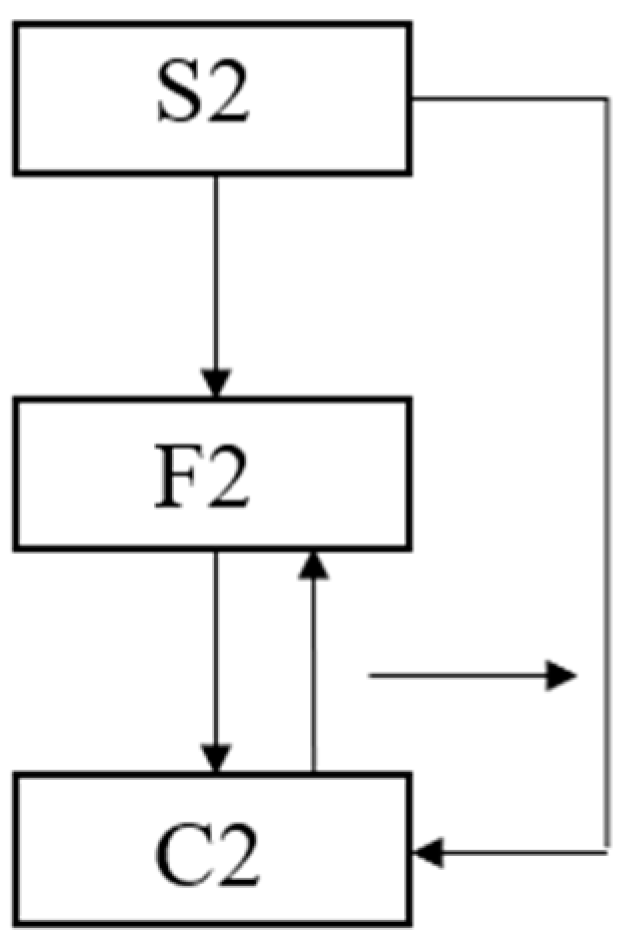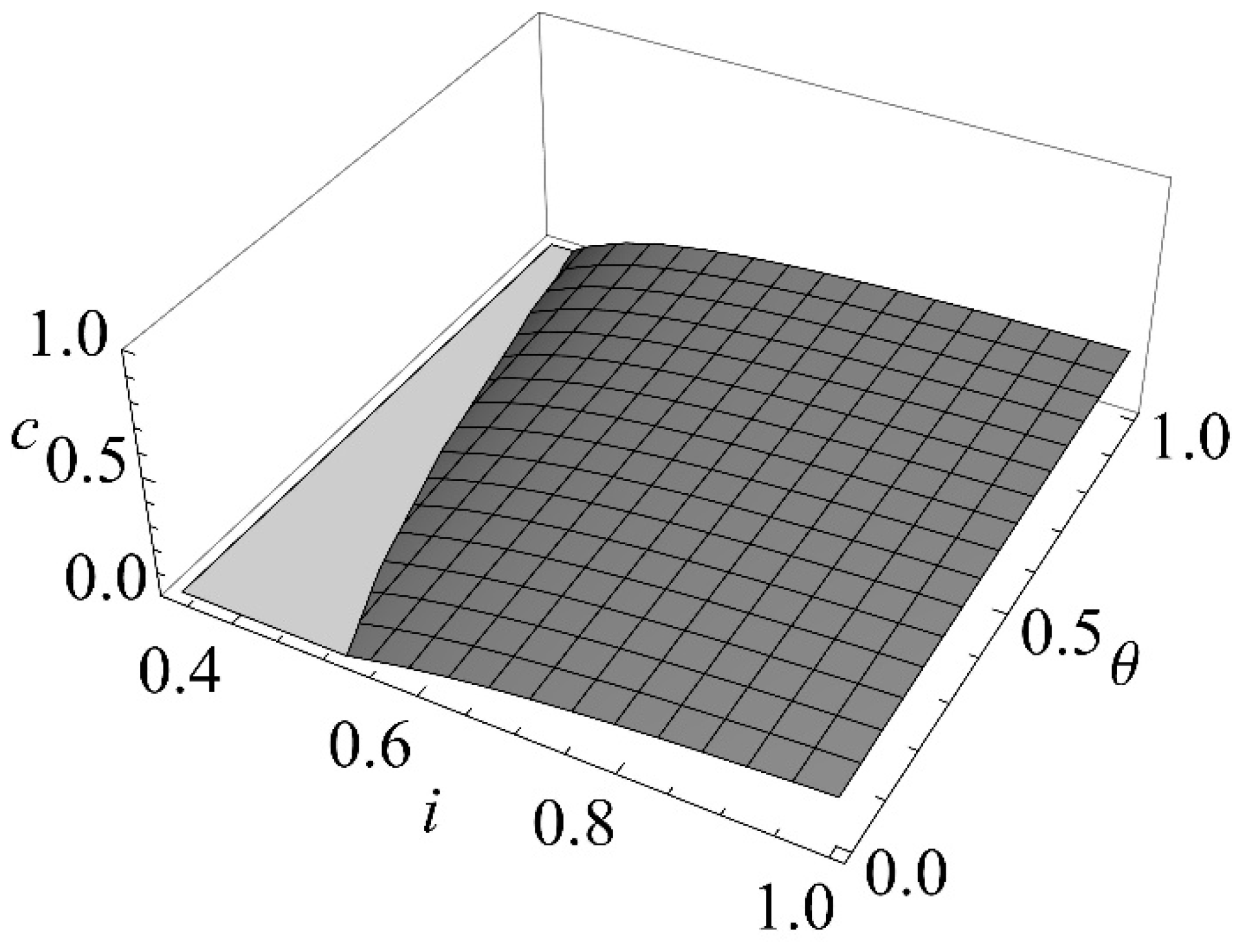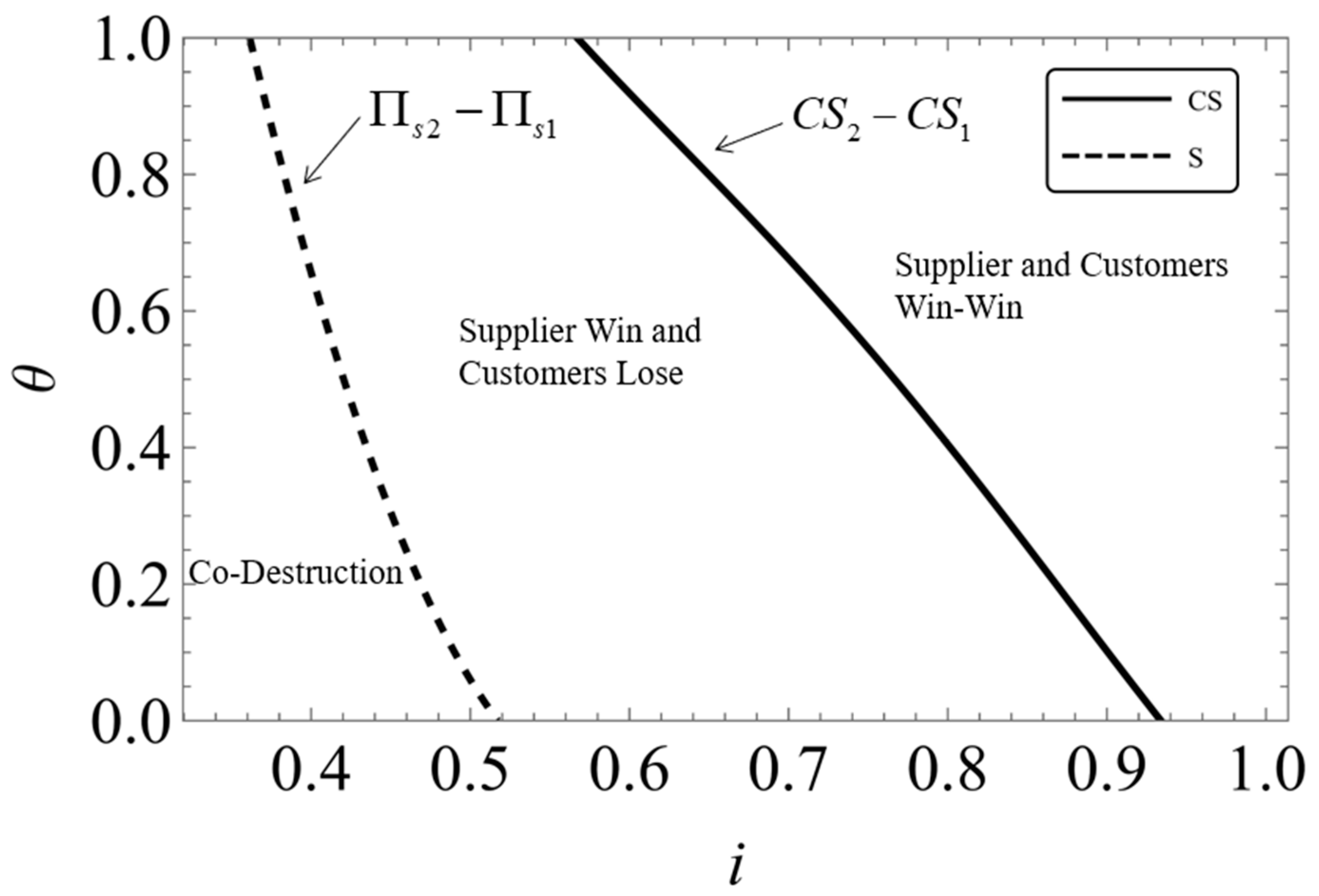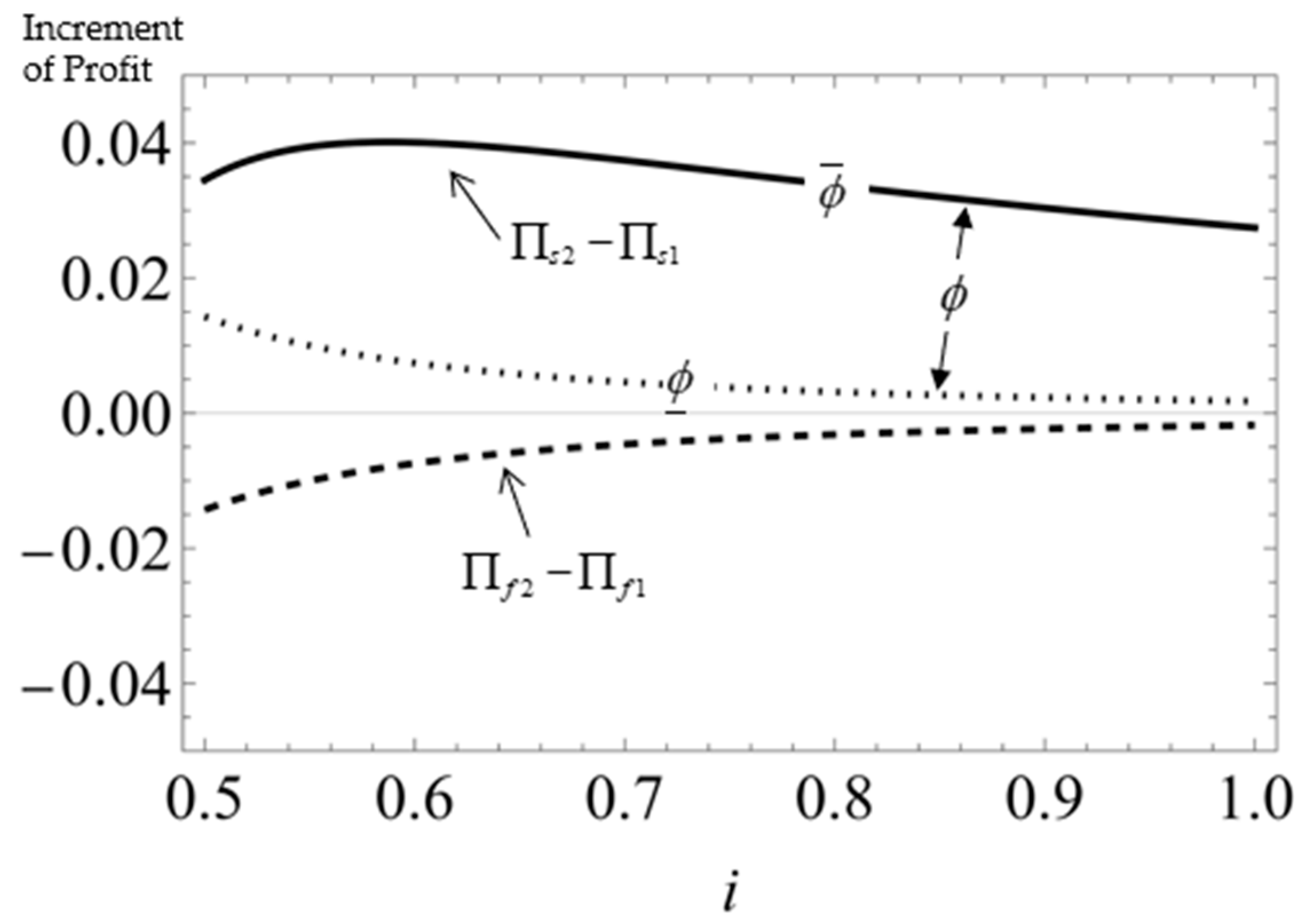The Implications of the Spillover Effect Related to Green Co-Creation in a Supply Chain
Abstract
1. Introduction
- (1)
- What are the implications of the spillover effect on the green co-creation levels of the downstream firm and the consumers?
- (2)
- What are the impacts of the spillover effect on the performance of different players in a green co-creation supply chain?
2. Literature Review
2.1. Green Co-Creation in Supply Chains
2.2. Inter-Channel Spillover in Supply Chains
3. The Models
3.1. The Green Co-Creation Model with No Spillover Effect (Model N)
3.2. The Green Co-Creation Model with Spillover Effect (Model S)
3.3. Analysis
3.3.1. The Comparison of Investment in Green Co-Creation Efforts
3.3.2. The Comparison of Channel Decisions
3.3.3. The Comparison of Profits
3.3.4. The Revenue-Sharing Contract
4. Discussion and Conclusions
4.1. Theoretical Implications for the Literature
4.2. Managerial Implications for Practice
4.3. Limitations and Future Research
Author Contributions
Funding
Institutional Review Board Statement
Informed Consent Statement
Data Availability Statement
Conflicts of Interest
Appendix A
Appendix A.1. The Equilibrium of Model N
Appendix A.2. The Equilibrium of Model S
Appendix A.3. The Feasible Range

References
- Fahimnia, B.; Sarkis, J.; Davarzani, H. Green supply chain management: A review and bibliometric analysis. Int. J. Prod. Econ. 2015, 162, 101–114. [Google Scholar] [CrossRef]
- Srivastava, S.K. Green supply-chain management: A state-of-the-art literature review. Int. J. Manag. Rev. 2007, 9, 53–80. [Google Scholar] [CrossRef]
- Li, G.; Shi, X.; Yang, Y.; Lee, P.K.C. Green Co-Creation Strategies among Supply Chain Partners: A Value Co-Creation Perspective. Sustainability 2020, 12, 4305. [Google Scholar] [CrossRef]
- Tian, H.-H.; Huang, S.-Z.; Cheablam, O. How green value co-creation mediates the relationship between institutional pressure and firm performance: A moderated mediation model. Bus. Strategy Environ. 2023, 32, 3309–3325. [Google Scholar] [CrossRef]
- Shi, X.; Li, G.; Dong, C.; Yang, Y. Value Co-Creation Behavior in Green Supply Chains: An Empirical Study. Energies 2020, 13, 3902. [Google Scholar] [CrossRef]
- Elliot, E.A.; Adams, R.; Tsetse, E.K.K. Customer Value Co-Creation: Environmental Sustainability as a Tourist Experience. Sustainability 2023, 15, 10486. [Google Scholar] [CrossRef]
- Simona Moise, M.; Gil-Saura, I.; Ruiz-Molina, M.-E. Implications of Value Co-Creation in Green Hotels: The Moderating Effect of Trip Purpose and Generational Cohort. Sustainability 2020, 12, 9866. [Google Scholar] [CrossRef]
- Adidas. More Sustainable Materials and Circular Services. Available online: https://www.adidas-group.com/en/sustainability/environmental-impacts/more-sustainable-materials-and-circular-services/ (accessed on 25 February 2024).
- Ranjan, K.R.; Read, S. Value co-creation: Concept and measurement. J. Acad. Mark. Sci. 2016, 44, 290–315. [Google Scholar] [CrossRef]
- Galvagno, M.; Dalli, D. Theory of value co-creation: A systematic literature review. Manag. Serv. Qual. 2014, 24, 643–683. [Google Scholar] [CrossRef]
- Hoyer, W.D.; Chandy, R.; Dorotic, M.; Krafft, M.; Singh, S.S. Consumer Cocreation in New Product Development. J. Serv. Res. 2010, 13, 283–296. [Google Scholar] [CrossRef]
- Colvin, R.M.; Witt, G.B.; Lacey, J. Power, perspective, and privilege: The challenge of translating stakeholder theory from business management to environmental and natural resource management. J. Environ. Manag. 2020, 271, 110974. [Google Scholar] [CrossRef] [PubMed]
- Tseng, M.-L.; Islam, M.S.; Karia, N.; Fauzi, F.A.; Afrin, S. A literature review on green supply chain management: Trends and future challenges. Resour. Conserv. Recycl. 2019, 141, 145–162. [Google Scholar] [CrossRef]
- Walmart. Product Supply Chain Sustainability. Available online: https://corporate.walmart.com/purpose/esgreport/environmental/product-supply-chain-sustainability (accessed on 25 February 2024).
- Ding, Y.; Zheng, D.; Niu, X. Collaborative Green Innovation of Livestock Product Three-Level Supply Chain Traceability System: A Value Co-Creation Perspective. Sustainability 2024, 16, 297. [Google Scholar] [CrossRef]
- Yousaf, Z. Go for green: Green innovation through green dynamic capabilities: Accessing the mediating role of green practices and green value co-creation. Environ. Sci. Pollut. Res. 2021, 28, 54863–54875. [Google Scholar] [CrossRef] [PubMed]
- Yu, H.; Zhang, J.; Zhang, M.; Fan, F. Cross-national knowledge transfer, absorptive capacity, and total factor productivity: The intermediary effect test of international technology spillover. Technol. Anal. Strateg. Manag. 2022, 34, 625–640. [Google Scholar] [CrossRef]
- Niesten, E.; Stefan, I. Embracing the Paradox of Interorganizational Value Co-creation-Value Capture: A Literature Review towards Paradox Resolution. Int. J. Manag. Rev. 2019, 21, 231–255. [Google Scholar] [CrossRef]
- Zhang, F.; Zhang, Z.; Xue, Y.; Zhang, J.; Che, Y. Dynamic Green Innovation Decision of the Supply Chain with Innovating and Free-Riding Manufacturers: Cooperation and Spillover. Complexity 2020, 2020, 8937847. [Google Scholar] [CrossRef]
- Hsieh, C.-C.; Lathifah, A. Exploring the spillover effect and supply chain coordination in dual-channel green supply chains with blockchain-based sales platform. Comput. Ind. Eng. 2024, 187, 109801. [Google Scholar] [CrossRef]
- Chen, X.; Wang, X.; Zhou, M. Firms’ green R&D cooperation behaviour in a supply chain: Technological spillover, power and coordination. Int. J. Prod. Econ. 2019, 218, 118–134. [Google Scholar] [CrossRef]
- Wu, Y.; Wang, J.; Chen, L. Optimization and Decision of Supply Chain Considering Negative Spillover Effect and Service Competition. Sustainability 2021, 13, 2320. [Google Scholar] [CrossRef]
- Ulrich, L. EV Rivals Join Tesla Supercharger Network. Available online: https://spectrum.ieee.org/tesla-supercharger-network-ford-gm (accessed on 16 April 2024).
- Lu, X.; Lin, J.; Wang, H.; Qian, Y. Extending a Product Line With a Product Applying Green Technology. Ieee Trans. Eng. Manag. 2024, 71, 3189–3204. [Google Scholar] [CrossRef]
- Gao, Y.; Tsai, S.-B.; Xue, X.; Ren, T.; Du, X.; Chen, Q.; Wang, J. An Empirical Study on Green Innovation Efficiency in the Green Institutional Environment. Sustainability 2018, 10, 724. [Google Scholar] [CrossRef]
- Cheng, P.; Wang, X.; Choi, B.; Huan, X. Green Finance, International Technology Spillover and Green Technology Innovation: A New Perspective of Regional Innovation Capability. Sustainability 2023, 15, 1112. [Google Scholar] [CrossRef]
- An, L.; Liu, J.; Zhang, Q.; Song, C.; Ezzine-de-Blas, D.; Dai, J.; Zhang, H.; Lewison, R.; Bohnett, E.; Stow, D.; et al. Global hidden spillover effects among concurrent green initiatives. Sci. Total Environ. 2024, 917, 169880. [Google Scholar] [CrossRef] [PubMed]
- Zhao, S.; Jiang, Y.; Wang, S. Innovation stages, knowledge spillover, and green economy development: Moderating role of absorptive capacity and environmental regulation. Environ. Sci. Pollut. Res. 2019, 26, 25312–25325. [Google Scholar] [CrossRef] [PubMed]
- Wang, M.; Zhang, X.; Hu, Y. The green spillover effect of the inward foreign direct investment: Market versus innovation. J. Clean. Prod. 2021, 328, 129501. [Google Scholar] [CrossRef]
- Vargo, S.L.; Lusch, R.F. Evolving to a New Dominant Logic for Marketing. J. Mark. 2004, 68, 1–17. [Google Scholar] [CrossRef]
- Lusch, R.F. Reframing Supply Chain Management: A Service-Dominant Logic Perspective. J. Supply Chain Manag. 2011, 47, 14–18. [Google Scholar] [CrossRef]
- Font, X.; English, R.; Gkritzali, A.; Tian, W. Value co-creation in sustainable tourism: A service-dominant logic approach. Tour. Manag. 2021, 82, 104200. [Google Scholar] [CrossRef]
- Vargo, S.L.; Lusch, R.F. Institutions and axioms: An extension and update of service-dominant logic. J. Acad. Mark. Sci. 2016, 44, 5–23. [Google Scholar] [CrossRef]
- Prahalad, C.K.; Ramaswamy, V. Co-creation experiences: The next practice in value creation. J. Interact. Mark. 2004, 18, 5–14. [Google Scholar] [CrossRef]
- Meyer-Waarden, L. The effects of loyalty programs on customer lifetime duration and share of wallet. J. Retail. 2007, 83, 223–236. [Google Scholar] [CrossRef]
- Ramaswamy, V.; Ozcan, K. What is co-creation? An interactional creation framework and its implications for value creation. J. Bus. Res. 2018, 84, 196–205. [Google Scholar] [CrossRef]
- Brodie, R.J.; Ilic, A.; Juric, B.; Hollebeek, L. Consumer engagement in a virtual brand community: An exploratory analysis. J. Bus. Res. 2013, 66, 105–114. [Google Scholar] [CrossRef]
- Saha, V.; Goyal, P.; Jebarajakirthy, C. Value co-creation: A review of literature and future research agenda. J. Bus. Ind. Mark. 2022, 37, 612–628. [Google Scholar] [CrossRef]
- Yao, Q.; Liang, Y.; Feng, M.; Wang, H. Are consumers willing to co-create value when focal firms' suppliers are proactive in green innovation? A chain liability and green halo effect. Int. J. Phys. Distrib. Logist. Manag. 2023, 53, 1240–1260. [Google Scholar] [CrossRef]
- Ameknassi, L.; Ait-Kadi, D.; Rezg, N. Integration of logistics outsourcing decisions in a green supply chain design: A stochastic multi-objective multi-period multi-product programming model. Int. J. Prod. Econ. 2017, 186, 132. [Google Scholar] [CrossRef]
- Zhu, Q.; Feng, Y.; Choi, S.-B. The role of customer relational governance in environmental and economic performance improvement through green supply chain management. J. Clean. Prod. 2017, 155, 46–53. [Google Scholar] [CrossRef]
- Rostamzadeh, R.; Govindan, K.; Esmaili, A.; Sabaghi, M. Application of fuzzy VIKOR for evaluation of green supply chain management practices. Ecol. Indic. 2016, 61, 1055. [Google Scholar] [CrossRef]
- Li, H.; Li, Z. Supplier Encroachment in the Supply Chain in the E-Commerce Age: A Systematic Literature Review. J. Theor. Appl. Electron. Commer. Res. 2021, 16, 2655–2671. [Google Scholar] [CrossRef]
- Li, Y.; Bosworth, D. R&D spillovers in a supply chain and productivity performance in British firms. J. Technol. Transf. 2020, 45, 177–204. [Google Scholar] [CrossRef]
- Song, H.; Lu, Q.; Yu, K.; Qian, C. How do knowledge spillover and access in supply chain network enhance SMEs’ credit quality? Ind. Manag. Data Syst. 2019, 119, 274–291. [Google Scholar] [CrossRef]
- Yoon, D.-H. Supplier Encroachment and Investment Spillovers. Prod. Oper. Manag. 2016, 25, 1839–1854. [Google Scholar] [CrossRef]
- Xia, J.; Niu, W. A perspective on supplier encroachment in the era of e-commerce. Electron. Commer. Res. Appl. 2020, 40, 100924. [Google Scholar] [CrossRef]
- Xue, M.; Zhang, J.; Zhu, G. Quantity decision timing with spillover effect and asymmetric demand information. Transp. Res. Part E Logist. Transp. Rev. 2020, 142, 102048. [Google Scholar] [CrossRef]
- Wu, H.; Li, G.; Zheng, H.; Zhang, X. Contingent channel strategies for combating brand spillover in a co-opetitive supply chain. Transp. Res. Part E Logist. Transp. Rev. 2022, 164, 102830. [Google Scholar] [CrossRef]
- Wu, J.; Zong, Y.; Liu, X. Cooperative Advertising in Dual-Channel Supply Chain Under Asymmetric Demand Information. Int. J. Electron. Commer. 2023, 27, 100–128. [Google Scholar] [CrossRef]
- Zhang, H.; Xu, H.; Pu, X. A Cross-Channel Return Policy in a Green Dual-Channel Supply Chain Considering Spillover Effect. Sustainability 2020, 12, 2171. [Google Scholar] [CrossRef]
- Hsu, Y.-J.; Wang, Y. Technology spillover, corporate investment, and stock returns. J. Empir. Financ. 2023, 73, 238–250. [Google Scholar] [CrossRef]
- Awasthy, P.; Gouda, S.; Ghosh, D.; Swami, S. Analyzing product greening spillovers in multi-product markets. Transp. Res. Part E Logist. Transp. Rev. 2022, 158, 102586. [Google Scholar] [CrossRef]
- Liu, Q.; Zhu, X. How Carbon Tax Policy Affects the Carbon Emissions of Manufacturers with Green Technology Spillovers? Environ. Model. Assess. 2024. [Google Scholar] [CrossRef]
- Zhao, Y.; Zhang, N.; Feng, T.; Zhao, C.; Zhang, J. The green spillover effect of green customer integration: Does internal integration matter? Corp. Soc. Responsib. Environ. Manag. 2020, 27, 325–338. [Google Scholar] [CrossRef]
- Tsay, A.A.; Agrawal, N. Channel conflict and coordination in the E-commerce age. Prod. Oper. Manag. 2004, 13, 93–110. [Google Scholar] [CrossRef]
- Arya, A.; Mittendorf, B.; Sappington, D.E.M. The bright side of supplier encroachment. Mark. Sci. 2007, 26, 651–659. [Google Scholar] [CrossRef]
- Hilty, R.M.; Batista, P.H.D. Potential and Limits of Patent Law to Address Climate Change. GRUR Int. 2023, 72, 821–839. [Google Scholar] [CrossRef]
- Liu, X.; Lin, K.; Wang, L.; Ding, L. Pricing Decisions for a Sustainable Supply Chain in the Presence of Potential Strategic Customers. Sustainability 2020, 12, 1655. [Google Scholar] [CrossRef]
- Guan, X.; Liu, B.; Chen, Y.-j.; Wang, H. Inducing Supply Chain Transparency through Supplier Encroachment. Prod. Oper. Manag. 2020, 29, 725–749. [Google Scholar] [CrossRef]
- Cai, G. Channel Selection and Coordination in Dual-Channel Supply Chains. J. Retail. 2010, 86, 22–36. [Google Scholar] [CrossRef]
- Van den Broeke, M.; Paparoidamis, N. Engaging in or escaping co-creation? An analytical model. Int. J. Prod. Econ. 2021, 231, 107917. [Google Scholar] [CrossRef]
- Schneider, P.A. The Future of Competition: Co-Creating Unique Value with Customers. J. Prod. Brand Manag. 2005, 14, 348. [Google Scholar] [CrossRef]
- Bhaskaran, S.R.; Krishnan, V. Effort, Revenue, and Cost Sharing Mechanisms for Collaborative New Product Development. Manag. Sci. 2009, 55, 1152–1169. [Google Scholar] [CrossRef]
- Ding, X.-H.; Huang, R.-H. Effects of knowledge spillover on inter-organizational resource sharing decision in collaborative knowledge creation. Eur. J. Oper. Res. 2010, 201, 949–959. [Google Scholar] [CrossRef]
- Bernstein, F.; Song, J.-S.; Zheng, X. Free Riding in a Multi-Channel Supply Chain. Nav. Res. Logist. 2009, 56, 745–765. [Google Scholar] [CrossRef]
- Alcacer, J.; Chung, W. Location strategies and knowledge spillovers. Manag. Sci. 2007, 53, 760–776. [Google Scholar] [CrossRef]
- Ofek, E.; Katona, Z.; Sarvary, M. “Bricks and Clicks”: The Impact of Product Returns on the Strategies of Multichannel Retailers. Mark. Sci. 2011, 30, 42–60. [Google Scholar] [CrossRef]
- Arya, A.; Mittendorf, B. The Changing Face of Distribution Channels: Partial Forward Integration and Strategic Investments. Prod. Oper. Manag. 2013, 22, 1077–1088. [Google Scholar] [CrossRef]
- Chen, Y.-S.; Chang, C.-H. The Determinants of Green Product Development Performance: Green Dynamic Capabilities, Green Transformational Leadership, and Green Creativity. J. Bus. Ethics 2013, 116, 107–119. [Google Scholar] [CrossRef]
- Tahirov, N.; Glock, C.H. Manufacturer encroachment and channel conflicts: A systematic review of the literature. Eur. J. Oper. Res. 2022, 302, 403–426. [Google Scholar] [CrossRef]
- Xu, S.; Yang, W.; Govindan, K.; Yang, J.; Zhou, M. A new coopetitive mode in a sustainable supply chain: Energy performance contracting and supplier encroachment. J. Clean. Prod. 2024, 450, 141795. [Google Scholar] [CrossRef]
- Zhang, X.; Li, G.; Liu, M.; Sethi, S.P. Online platform service investment: A bane or a boon for supplier encroachment. Int. J. Prod. Econ. 2021, 235, 108079. [Google Scholar] [CrossRef]
- Tseng, M.-L.; Tan, P.A.; Jeng, S.-Y.; Lin, C.-W.R.; Negash, Y.T.; Darsono, S.N.A.C. Sustainable Investment: Interrelated among Corporate Governance, Economic Performance and Market Risks Using Investor Preference Approach. Sustainability 2019, 11, 2108. [Google Scholar] [CrossRef]
- Zheng, S.; Jin, S. Can Enterprises in China Achieve Sustainable Development through Green Investment? Int. J. Environ. Res. Public Health 2023, 20, 1787. [Google Scholar] [CrossRef] [PubMed]
- Daunt, K.L.; Harris, L.C. Consumer showrooming: Value co-destruction. J. Retail. Consum. Serv. 2017, 38, 166–176. [Google Scholar] [CrossRef]
- Hsiung, T.-F.; Cheng, Y.-H.; Han, Z.-X. Sustainable Partnership: Operational Condition Analysis for Brand Value Co-Creation. Sustainability 2021, 13, 6516. [Google Scholar] [CrossRef]
- Mazzoleni, R.; Nelson, R.R. The benefits and costs of strong patent protection: A contribution to the current debate. Res. Policy 1998, 27, 273–284. [Google Scholar] [CrossRef]






| Literature | Green Co-Creation in Supply Chain | Inter-Channel Spillover in Supply Chain |
|---|---|---|
| Li, et al. [3], Ding, et al. [15], etc. | √ | × |
| Hsieh and Lathifah [20], Chen, et al. [21], Lu, et al. [24], etc. | × | √ |
| This paper | √ | √ |
| Variable | Definition |
|---|---|
| Highest potential price in the market | |
| The investment parameter of green co-creation activities | |
| Transaction cost in direct channel | |
| Spillover rate of green co-creation | |
| Wholesale price to focal firm set by supplier | |
| Co-creation efforts invested by consumers/focal firm | |
| Price of products sold by focal firm/direct channel of supplier | |
| Sales of focal firm/direct channel of supplier | |
| Profit of business entities (i.e., supplier or focal firm) | |
| Consumer surplus |
| Model N | |||
|---|---|---|---|
| Model S | |||
Disclaimer/Publisher’s Note: The statements, opinions and data contained in all publications are solely those of the individual author(s) and contributor(s) and not of MDPI and/or the editor(s). MDPI and/or the editor(s) disclaim responsibility for any injury to people or property resulting from any ideas, methods, instructions or products referred to in the content. |
© 2024 by the authors. Licensee MDPI, Basel, Switzerland. This article is an open access article distributed under the terms and conditions of the Creative Commons Attribution (CC BY) license (https://creativecommons.org/licenses/by/4.0/).
Share and Cite
Kong, W.; Shao, Y.; Wang, S.; Yan, W.; Liu, Y. The Implications of the Spillover Effect Related to Green Co-Creation in a Supply Chain. Sustainability 2024, 16, 3704. https://doi.org/10.3390/su16093704
Kong W, Shao Y, Wang S, Yan W, Liu Y. The Implications of the Spillover Effect Related to Green Co-Creation in a Supply Chain. Sustainability. 2024; 16(9):3704. https://doi.org/10.3390/su16093704
Chicago/Turabian StyleKong, Weijia, Yunfei Shao, Simeng Wang, Wei Yan, and Yawen Liu. 2024. "The Implications of the Spillover Effect Related to Green Co-Creation in a Supply Chain" Sustainability 16, no. 9: 3704. https://doi.org/10.3390/su16093704
APA StyleKong, W., Shao, Y., Wang, S., Yan, W., & Liu, Y. (2024). The Implications of the Spillover Effect Related to Green Co-Creation in a Supply Chain. Sustainability, 16(9), 3704. https://doi.org/10.3390/su16093704






